Related Research Articles

In nutrition, biology, and chemistry, fat usually means any ester of fatty acids, or a mixture of such compounds, most commonly those that occur in living beings or in food.

Ham is pork from a leg cut that has been preserved by wet or dry curing, with or without smoking. As a processed meat, the term "ham" includes both whole cuts of meat and ones that have been mechanically formed.

Mortadella is a large Italian sausage or luncheon meat made of finely hashed or ground meat-cured pork, which incorporates at least 15% small cubes of pork fat. It is traditionally flavoured with black pepper grains, but modern versions can also contain pistachios or, more rarely, myrtle berries.
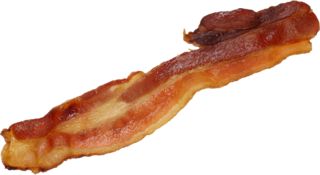
Bacon is a type of salt-cured pork made from various cuts, typically the belly or less fatty parts of the back. It is eaten as a side dish, used as a central ingredient, or as a flavouring or accent.

A sausage is a type of meat product usually made from ground meat—often pork, beef, or poultry—along with salt, spices and other flavourings. Other ingredients, such as grains or breadcrumbs may be included as fillers or extenders.

Jerky is lean trimmed meat cut into strips and dried (dehydrated) to prevent spoilage. Normally, this drying includes the addition of salt to prevent some forms of bacteria growth and encourages offers before the meat has finished the dehydrating process. It originated in the Andes mountains in what is modern day Peru and the word "jerky" derives from the Quechua word ch'arki which means "dried, salted meat". All that is needed to produce basic "jerky" is a low-temperature drying method, and salt to inhibit bacterial growth.

Salami is a cured sausage consisting of fermented and air-dried meat, typically pork. Historically, salami was popular among Southern, Eastern, and Central European peasants because it can be stored at room temperature for up to 45 days once cut, supplementing a potentially meager or inconsistent supply of fresh meat. Countries and regions across Europe make their own traditional varieties of salami.
An unsaturated fat is a fat or fatty acid in which there is at least one double bond within the fatty acid chain. A fatty acid chain is monounsaturated if it contains one double bond, and polyunsaturated if it contains more than one double bond.

Chorizo is a type of pork cured meat originating from the Iberian Peninsula.
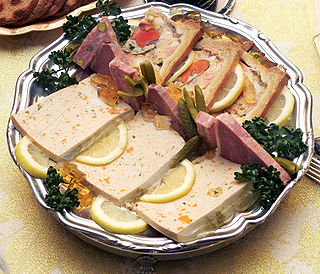
Offal, also called variety meats, pluck or organ meats, is the internal organs of a butchered animal. The word does not refer to a particular list of edible organs, and these lists of organs vary with culture and region, but usually exclude skeletal muscle. Offal may also refer to the by-products of human meat or of milled grains, such as corn or wheat.

Lunch meats—also known as cold cuts, luncheon meats, cooked meats, sliced meats, cold meats, sandwich meats, and deli meats—are precooked or cured meats that are sliced and served cold or hot. They are typically served in sandwiches or on a tray. They can be purchased pre-sliced, usually in vacuum packs, or they can be sliced to order.
Romanian cuisine is a diverse blend of different dishes from several traditions with which it has come into contact, but it also maintains its own character. It has been mainly influenced by Turkish and a series of European cuisines in particular from the Balkans, or Hungarian cuisine as well as culinary elements stemming from the cuisines of Central Europe.

Chistorra is a type of fast-cure sausage from Aragon, the Basque Country and Navarre, Spain. It can be considered a special type of chorizo. It is made of minced pork, or a mixture of minced pork and beef, is encased in either lamb tripe or plastic and has a fat content that varies between 70 and 80%. The sausage is flavoured with garlic, salt and paprika, which gives it a bright-red colour. It is usually baked, fried or grilled and often accompanies other dishes, sometimes as part of tapas. The final cured product tends to be thinner than traditional chorizo or sausage, with a diameter of approximately 25 mm. The sausages average 40 cm (16 in) in length, though there are cases when they reach up to 1 m long.
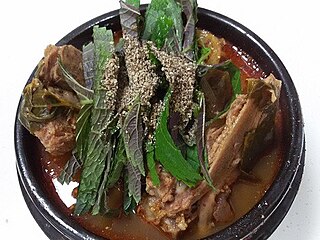
Gamja-tang (감자탕) or pork back-bone stew is a spicy Korean soup made from the spine or neck bones of a pig. It often contains potatoes, cellophane noodles, dried radish greens, perilla leaves, green onions, hot peppers and ground sesame seeds.

Curing is any of various food preservation and flavoring processes of foods such as meat, fish and vegetables, by the addition of salt, with the aim of drawing moisture out of the food by the process of osmosis. Because curing increases the solute concentration in the food and hence decreases its water potential, the food becomes inhospitable for the microbe growth that causes food spoilage. Curing can be traced back to antiquity, and was the primary method of preserving meat and fish until the late 19th century. Dehydration was the earliest form of food curing. Many curing processes also involve smoking, spicing, cooking, or the addition of combinations of sugar, nitrate, and nitrite.
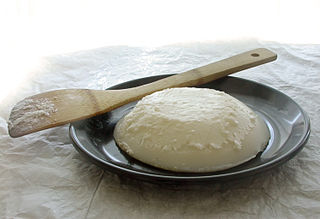
Lard is a semi-solid white fat product obtained by rendering the fatty tissue of a pig. It is distinguished from tallow, a similar product derived from fat of cattle or sheep.

The brain, like most other internal organs, or offal, can serve as nourishment. Brains used for nourishment include those of pigs, squirrels, rabbits, horses, cattle, monkeys, chickens, camels, fish, lamb, and goats. In many cultures, different types of brain are considered a delicacy.
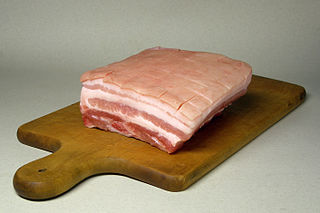
Pork is the culinary name for the meat of the pig. It is the most commonly consumed meat worldwide, with evidence of pig husbandry dating back to 5000 BCE.

imagemap_invalid_image
References
- ↑ "Pork 101: Nutrition Facts and Health Effects". Healthline. 2019-03-28. Retrieved 2021-11-30.
- ↑ "The world's most nutritious foods". www.bbc.com. Retrieved 2021-11-30.
- ↑ "Pork fat ranked among top 10 most nutritious foods: Report". AsiaOne. 2018-03-01. Retrieved 2021-11-30.